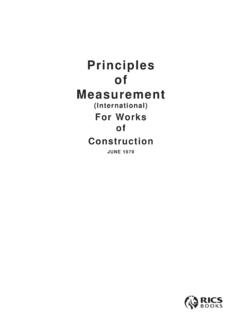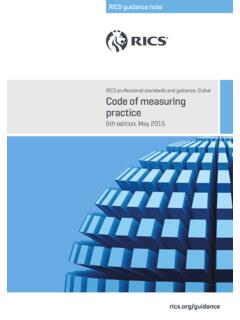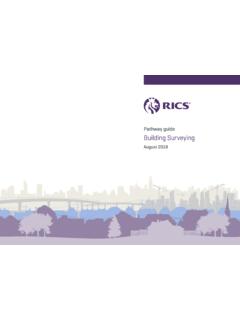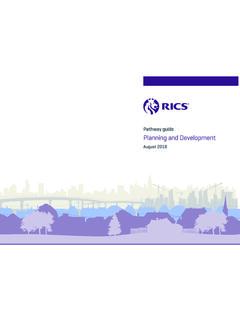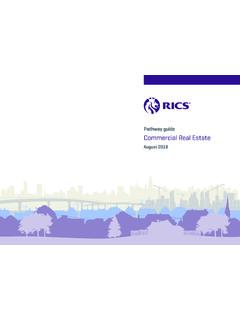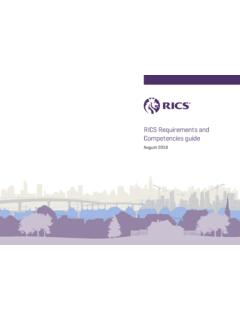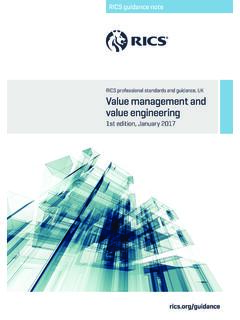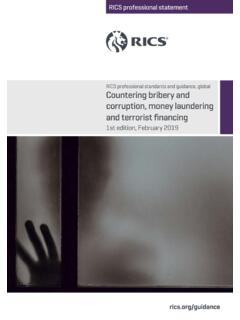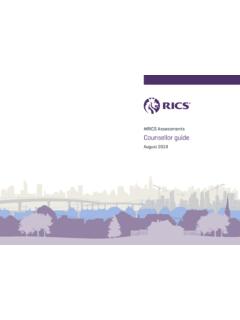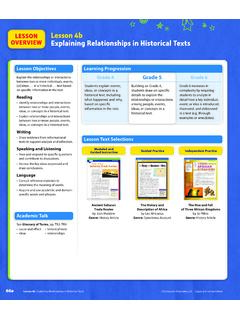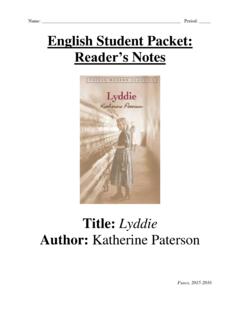Transcription of Description of the RICS Home Survey Level 3
1 Description of the rics home Survey Level 3 The service The rics home Survey Level 3 service includes: a thorough i nspection of the property (see The inspection below) and a detailed report based on the inspection (see The report below). The surveyor who provides the rics home Survey Level 3 service aims to give you professional advice to: help you make a reasoned and informed decision when purchasing the property, or when planning for repairs, maintenance or upgrading the property provide detailed advice on condition describe the identifiable risk of potential or hidden defects propose the most probable cause(s) of the defects based on the inspection and where practicable and agreed, provide an estimate of costs and likely timescale for identified repairs and necessary work.
2 Any extra services provided that are not covered by the terms and conditions of this service must be covered by a separate contract. The inspection The surveyor carefully and thoroughly inspects the inside and outside of the main building and all permanent outbuildings, recording the construction and defects that are evident. This inspection is intended to cover as much of the property as is physically accessible. Where this is not possible, an explanation is provided in the Limitations on the inspection box in the relevant section of the report. The surveyor does not force or open up the fabric of the building without occupier/owner consent, or if there is a risk of causing personal injury or damage. This includes taking up fitted carpets and fitted floor coverings or floorboards; moving heavy furniture; removing the contents of cupboards, roof spaces, etc.
3 Removing secured panels and/or hatches; or undoing electrical fittings. If necessary, the surveyor carries out parts of the inspection when standing at ground Level from adjoining public property where accessible. This means the extent of the inspection will depend on a range of individual circumstances at the time of inspection, and the surveyor judges each case on an individual basis. The surveyor uses equipment such as a damp meter, binoculars and torch, and uses a ladder for flat roofs and for hatches no more than 3m above Level ground (outside) or floor surfaces (inside) if it is safe to do so. If it is safe and reasonable to do so, the surveyor will enter the roof space and visually inspect the roof structure with attention paid to those parts vulnerable to deterioration and damage.
4 Although thermal insulation is not moved, small corners should be lifted so its thickness and type, and the nature of underlying ceiling can be identified (if the surveyor considers it safe to do). The surveyor does not move stored goods or other contents. The surveyor also carries out a desk-top study and makes oral enquiries for information about matters affecting the property. Services to the property Services are generally hidden within the construction of the property. This means that only the visible parts of the available services can be inspected, and the surveyor does not carry out specialist tests. The visual inspection cannot assess the efficiency or safety of electrical, gas or other energy sources. It also does not investigate the plumbing, heating or drainage installations (or whether they meet current regulations); or the internal condition of any chimney, boiler or other flue).
5 Outside the property The surveyor inspects the condition of boundary walls, fences, permanent outbuildings and areas in common (shared) use. To inspect these areas, the surveyor walks around the grounds and any neighbouring public property where access can be obtained. Where there are restrictions to access ( a creeper plant prevents closer inspection), these are reported and advice is given on any potential underlying risks that may require further investigation. Buildings with swimming pools and sports facilities are treated as permanent outbuildings and are therefore inspected, but the surveyor does not report on the leisure facilities, such as the pool itself and its equipment internally and externally, landscaping and other facilities (for example, tennis courts and temporary outbuildings).
6 Flats When inspecting flats, the surveyor assesses the general condition of the outside surfaces of the building, as well as its access and communal areas (for example, shared hallways and staircases that lead directly to the subject flat) and roof spaces, but only if they are accessible from within or owned by the subject flat or communal areas. The surveyor also inspects (within the identifiable boundary of the subject flat) drains, lifts, fire alarms and security systems, although the surveyor does not carry out any specialist tests other than their normal operation in everyday use. External wall systems are not inspected. If the surveyor has specific concerns about these items, further investigation will be recommended prior to legal commitment to purchase.
7 Dangerous materials, contamination and environmental issues The surveyor makes enquiries about contamination or other environmental dangers. If the surveyor suspects a problem, they recommend a further investigation. The surveyor may assume that no harmful or dangerous materials have been used in the construction, and does not have a duty to justify making this assumption. However, if the inspection shows that such materials have been used, the surveyor must report this and ask for further instructions. The surveyor does not carry out an asbestos inspection and does not act as an asbestos inspector when inspecting properties that may fall within The Control of Asbestos Regulations 2012 ( CAR 2012 ). However, the report should properly emphasise the suspected presence of asbestos containing materials if the inspection identifies that possibility.
8 With flats, the surveyor assumes that there is a dutyholder (as defined in the regulations), and that there is an asbestos register and an effective management plan in place, which does not present a significant risk to health or need any immediate payment. The surveyor does not consult the dutyholder. The report The surveyor produces a report of the inspection results for you to use, but cannot accept any liability if it is used by anyone else. If you decide not to act on the advice in the report, you do this at your own risk. The report is aimed at providing you with a detailed understanding of the condition of the property to allow you to make an informed decision on serious or urgent repairs, and on the maintenance of a wide range of reported issues.
9 Condition ratings The surveyor gives condition ratings to the main parts (the elements ) of the main building, garage and some outside elements. The condition ratings are described as follows: R Documents we may suggest you request before you sign contracts. C ondition rating 3 Defects that are serious and/or need to be repaired, replaced or investigated urgently. Failure to do so could risk serious safety issues or severe long-term damage to your property. Written quotations for repairs should be obtained prior to legal commitment to purchase. C ondition rating 2 Defects that need repairing or replacing but are not considered to be either serious or urgent. The property must be maintained in the normal way. C ondition rating 1 No repair is currently needed.
10 The property must be maintained in the normal way. NI Elements not inspected. The surveyor notes in the report if it was not possible to check any parts of the property that the inspection would normally cover. If the surveyor is concerned about these parts, the report tells you about any further investigations that are needed. Energy The surveyor has not prepared the Energy Performance Certificate (EPC) as part of the rics home Survey Level 3 service for the property. Where the EPC has not been made available by others, the surveyor will obtain the most recent certificate from the appropriate central registry where practicable. If the surveyor has seen the current EPC, they will review and state the relevant energy efficiency rating in this report.
